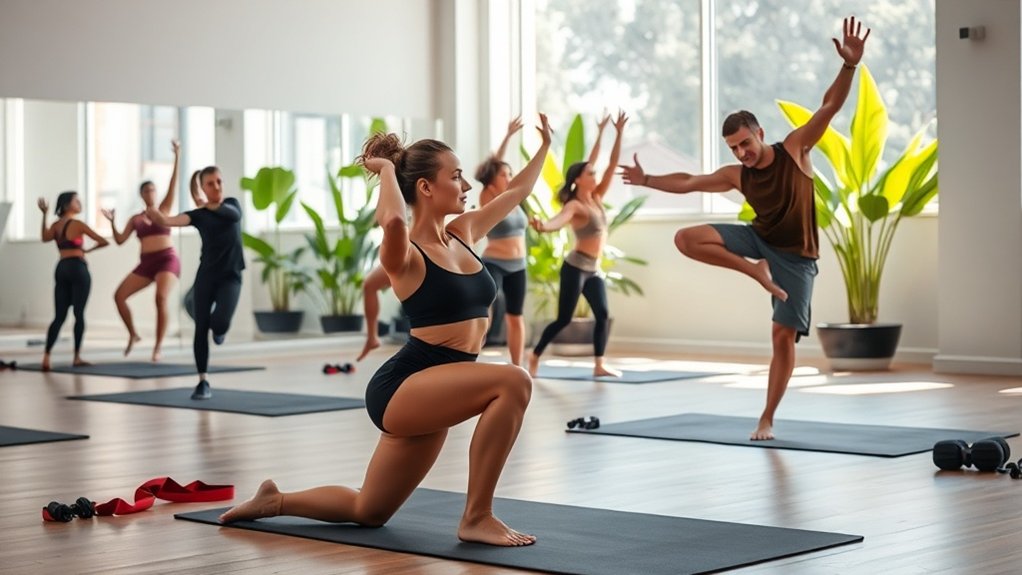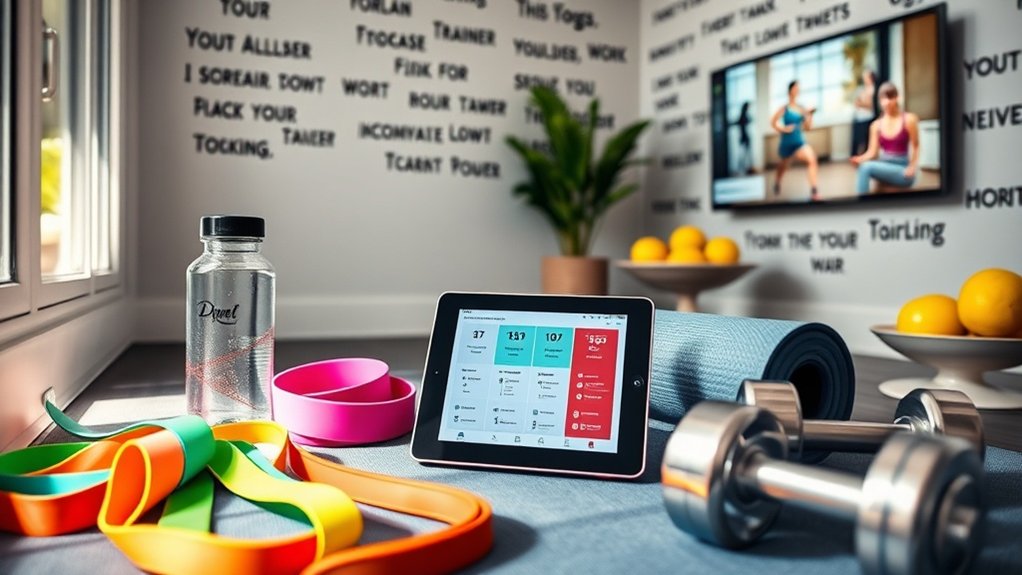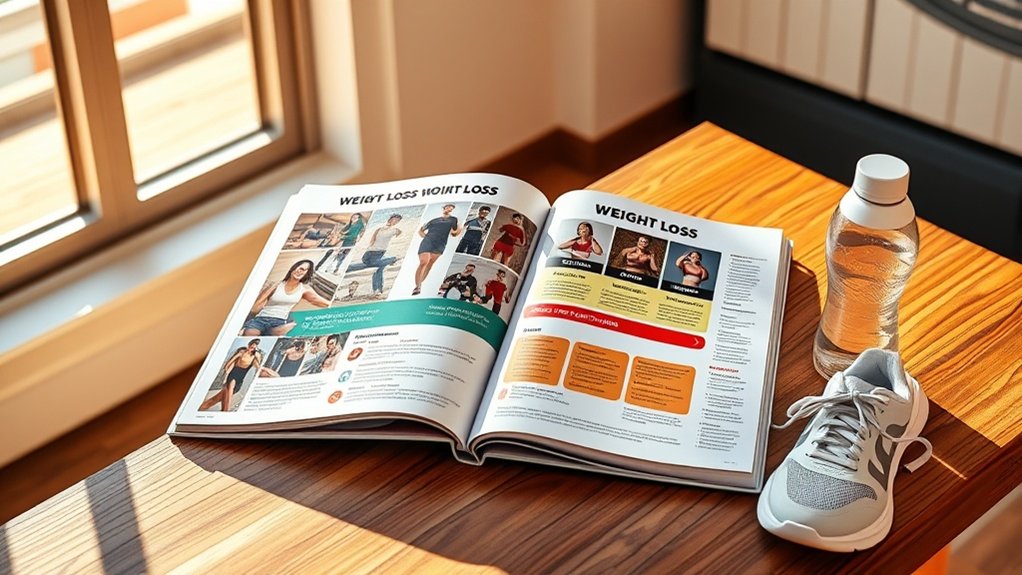Your custom flexibility plan should combine 5-10 minutes of daily joint-by-joint mobility work with 2-3 weekly dedicated stretching sessions. You’ll want to perform dynamic stretches before workouts to activate your neuromuscular system, then incorporate static stretches (15-30 seconds per position) and PNF techniques post-workout. Track your baseline range of motion using goniometry or sit-and-reach tests, then reassess every 4-6 weeks. Balance flexibility training with stability exercises to prevent injury while expanding your functional movement capacity through evidence-based protocols that address your specific limitations.
Understanding Flexibility and Mobility: Key Differences and Assessment Methods

While many people use the terms interchangeably, flexibility and mobility represent distinct components of your movement capacity that require different training approaches.
Flexibility describes your muscles’ passive lengthening ability, while mobility encompasses active movement and control throughout your joint’s complete range of motion. You might possess excellent flexibility yet lack the strength and stability for dynamic movement patterns, increasing your injury risk during functional activities.
Assessment methods help identify your specific limitations. The overhead squat test evaluates both flexibility and stability across multiple joints simultaneously, revealing muscle tightness and control deficiencies.
Understanding these distinctions enables you to develop targeted training programs that address your unique needs. Regular mobility work improves joint health by integrating flexibility, strength, and stability, creating sustainable improvements in your overall movement quality.
Dynamic Stretching Protocols for Pre-Workout Preparation
Before you engage in any workout, dynamic stretching activates your neuromuscular system and prepares your body for movement-specific demands. This pre-workout preparation improves blood flow and raises muscle temperature through controlled movements, greatly contributing to injury prevention.
You’ll maximize athletic performance by dedicating 5-10 minutes to dynamic stretching, targeting major muscle groups with exercises like leg swings, arm circles, and torso twists.
Research demonstrates that dynamic stretching increases power, speed, and agility more effectively than static alternatives. Your flexibility training should incorporate movements that mirror your upcoming activity’s specific patterns, maximizing functional range of motion.
This approach to mobility training guarantees your muscles and joints operate at their best throughout their full movement capacity, establishing the physiological foundation necessary for safe, effective exercise performance.
Static Stretching and PNF Techniques: Timing, Duration, and Application
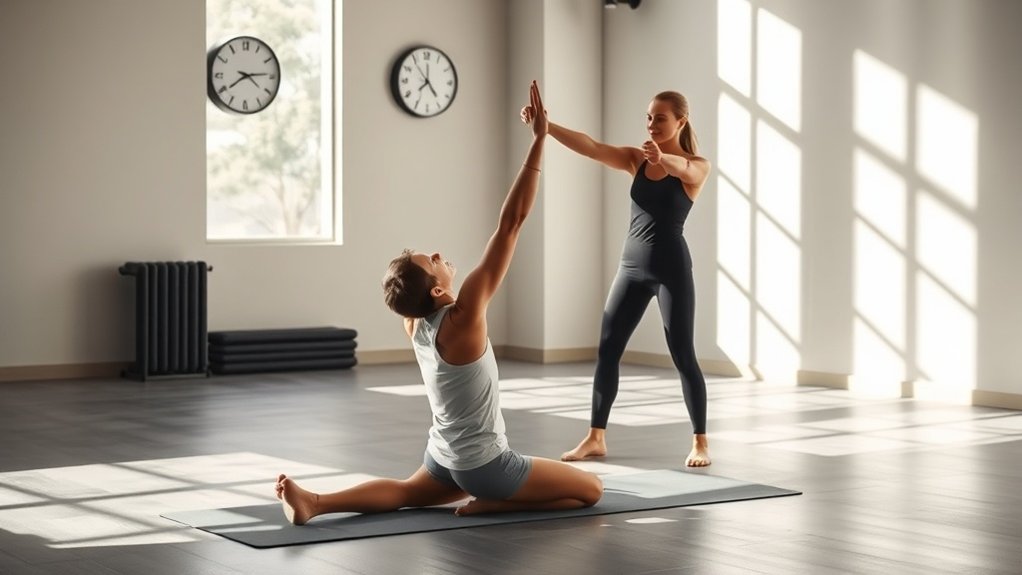
After completing your workout, static stretching becomes your primary tool for improving long-term flexibility and facilitating muscle recovery.
With warm muscles, you’ll reduce injury risk while maximizing range of motion gains.
Optimal Application Protocol:
- Static Stretching Duration: Hold each position for 15 to 30 seconds, targeting major muscle groups when tissues are thoroughly warmed post-exercise.
- PNF Techniques Sequence: Contract the target muscle for 5 to 10 seconds, then stretch for 15 to 30 seconds to achieve deeper relaxation.
- Session Timing: Reserve static stretching for post-workout cooldowns; schedule PNF techniques during dedicated flexibility sessions or after strength training.
- Progression Strategy: Maintain consistent practice of both methods to improve athletic performance and achieve measurable improvements in overall flexibility.
This evidence-based approach guarantees you’re optimizing muscle adaptation while minimizing potential strain.
Joint-by-Joint Mobility Training: Targeted Exercises for Full-Body Range of Motion
Building on your stretching foundation, joint-by-joint mobility training addresses movement capacity at each articulation point throughout your body’s kinetic chain.
This systematic approach improves range of motion by targeting specific joints through focused mobility exercises like the World’s Greatest Stretch and 90/90 Hip Switch, which improve overall functional movement patterns.
You’ll reduce risk of injury by dedicating just 5-10 minutes to targeted exercises in your daily routine.
These full body stretches strengthen surrounding musculature while expanding joint flexibility, directly translating to improved athletic performance.
Track your progress through video assessments and workout journals to identify limitations requiring additional attention.
Consistent joint-by-joint mobility training creates measurable improvements in movement efficiency, allowing greater strength and power expression throughout your complete range of motion.
Creating Your Personalized Flexibility Workout Plan: Frequency and Progression

Your flexibility training program requires strategic planning across three essential components: training frequency, intensity-volume balance, and progressive adaptation.
Research demonstrates that 2-3 weekly sessions provide the minimum effective dose for measurable improvements in range of motion, while your body’s response to these sessions dictates appropriate volume adjustments.
You’ll need to systematically modify your training parameters as your tissues adapt, making sure continued progress without compromising recovery or risking overuse injuries.
Optimal Weekly Training Frequency
When establishing your flexibility training schedule, research indicates that beginners achieve exceptional results with 2-3 dedicated sessions per week, progressively advancing to 4 sessions as your body adapts to the movement patterns.
To maximize your ideal weekly training frequency and improve flexibility, implement these evidence-based strategies:
- Dedicate 5-10 minutes daily to mobility work rather than lengthy, infrequent sessions—consistency yields superior outcomes.
- Incorporate flexibility routines into existing warm-ups or cooldowns to establish sustainable habits.
- Track progress through video documentation or training logs to identify improvement patterns and areas requiring attention.
- Gradually intensify stretching sessions as your range of motion expands to prevent adaptation plateaus.
This systematic approach to flexibility training guarantees continuous improvement while accommodating your body’s recovery requirements and maintaining long-term adherence.
Balancing Intensity and Volume
Strategic manipulation of training intensity and volume represents the cornerstone of sustainable flexibility development, requiring careful calibration between high-intensity deep stretching protocols and moderate-intensity dynamic mobility work.
You’ll achieve ideal range of motion by performing focused, high-intensity stretch sessions twice weekly, complemented by lighter mobility exercises on alternate days. This approach prevents overtraining while maximizing flexibility gains.
Monitor your progress through video documentation and maintaining a detailed routine journal to assess adaptations. Consistency remains paramount—integrate brief five-to-ten-minute targeted mobility sessions daily, addressing specific areas experiencing restriction.
As you advance, gradually increase your weekly volume from two-to-three sessions to four, confirming adequate recovery between high-intensity protocols. This balanced framework supports sustainable improvements while minimizing injury risk and promoting long-term flexibility improvement.
Adjusting Plans Over Time
As your neuromuscular adaptations plateau and initial flexibility improvements stabilize, you’ll need systematic progression adjustments to sustain measurable gains beyond the foundational phase.
Your workout plan requires periodic modifications to improve overall range of motion and maintain consistency in your flexibility training.
Strategic progression methods:
- Reassess flexibility every 4-6 weeks using standardized measurements to identify stagnant areas requiring targeted mobility routines.
- Adjust intensity by extending hold durations from 30 to 60 seconds or incorporating proprioceptive neuromuscular facilitation techniques.
- Increase frequency from 2-3 weekly stretching sessions to 4-6 as tissue tolerance develops.
- Document performance metrics tracking specific flexibility goals, noting improvements in functional movement patterns.
This evidence-based approach guarantees continuous adaptation while preventing overtraining and maintaining sustainable progress toward improved mobility.
Tracking Flexibility Progress: Benchmarks, Testing, and Adjustments
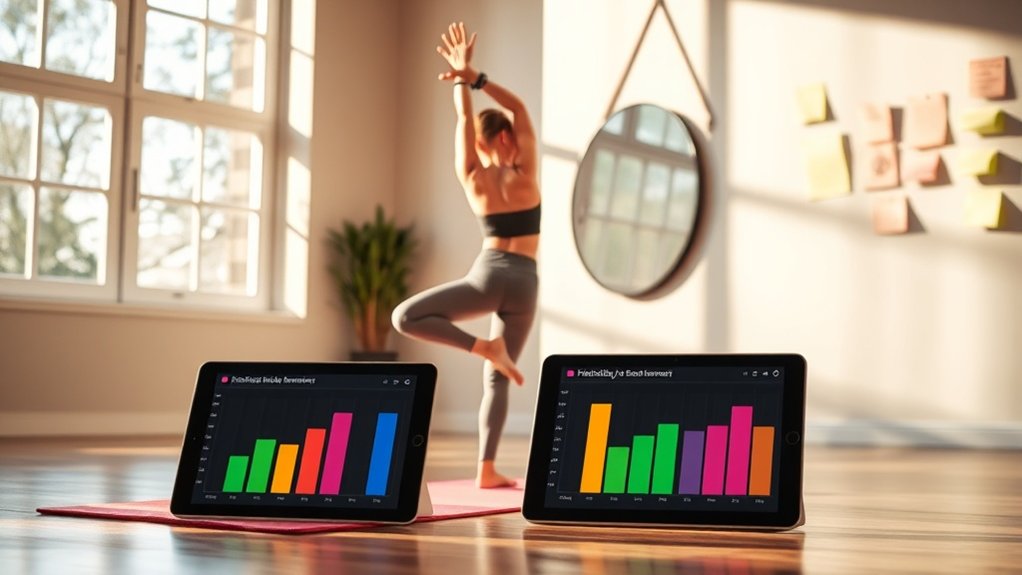
To optimize your flexibility training outcomes, you’ll need systematic methods to quantify your range of motion improvements and identify areas requiring intervention.
Establishing baseline measurements through goniometry or standardized functional tests like the sit-and-reach provides objective data points for comparison during reassessment intervals of 4-6 weeks.
Based on these empirical findings, you can make evidence-informed modifications to your routine’s intensity, duration, or exercise selection to address plateaus and guarantee continued adaptation.
Establish Baseline Flexibility Measurements
Baseline flexibility measurements provide the objective foundation for your customized training program, enabling you to identify specific limitations and track meaningful progress over time.
You’ll assess range of motion in critical areas—hips, shoulders, and spine—to establish your current capacity and define flexibility goals aligned with individual needs.
Essential baseline assessment components:
- Sit-and-reach testing quantifies hamstring and lower back flexibility
- Goniometer measurements determine precise joint angles across major articulations
- Document findings in your workout journal for thorough progress tracking
- Schedule reassessments every 4-6 weeks to evaluate training routines effectiveness
These flexibility measurements allow evidence-based modifications to intensity and focus areas, assuring your program remains responsive to demonstrated improvements or plateaus.
This systematic approach helps optimize flexibility development through data-driven training adjustments.
Regular Testing and Reassessment
Your initial measurements serve as reference points that require systematic monitoring through structured reassessment protocols.
Regular testing every 4-6 weeks using goniometers or standardized assessments like the sit-and-reach test enables you to track flexibility improvements objectively.
Document each stretching session’s details—exercise types, duration, and intensity—in your workout journal to identify patterns requiring attention.
These benchmarks establish whether your flexibility routine effectively increases range of motion or needs modification.
When progress plateaus, reassessment data guides necessary adjustments to your workout plan, such as incorporating new exercises or increasing stretching session frequency.
This evidence-based approach maintains alignment between your flexibility training and personal fitness objectives while boosting motivation through visible progress documentation and strategic routine refinement.
Modify Routines Based on Results
When your reassessment data reveals specific patterns—whether plateaus, regressions, or accelerated gains—you’ll need to implement targeted modifications that address these findings directly.
Your workout journal provides essential insights into which exercises yield ideal improvements in range of motion and which movement patterns require additional attention.
Base your adjust routines decisions on concrete flexibility benchmarks and progress tracking data:
- Increase hold times by 10-15 seconds when you’ve maintained current positions comfortably for two consecutive weeks.
- Add progressive variations to exercises where you’ve achieved target flexibility benchmarks.
- Reduce intensity in areas showing regression or discomfort until proper form returns.
- Introduce complementary movements targeting underperforming muscle groups identified through weekly assessments.
These evidence-based modifications promote continuous progress while preventing overtraining.
Balancing Flexibility With Stability and Strength for Injury Prevention
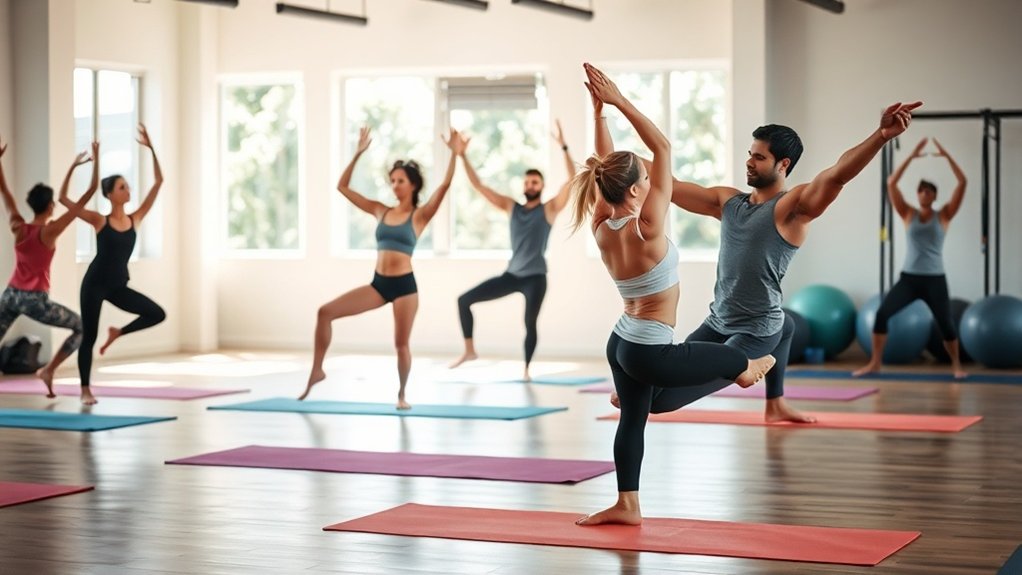
While increased range of motion offers clear benefits, flexibility alone won’t protect you from injury—and can paradoxically increase your risk if you lack the stability and strength to control that newfound mobility.
Your training plan must address all three components simultaneously. Strong, stable muscle groups provide essential support for flexible joints, preventing overextension and strain during functional movement.
Research demonstrates that integrating strength training with flexibility work notably reduces musculoskeletal injury risk while increasing performance.
Focus on dynamic mobility exercises that challenge both range of motion and control within that range. This thorough approach develops the neuromuscular coordination necessary for safe movement patterns.
Frequently Asked Questions
How to Improve Flexibility and Range of Motion?
You’ll improve flexibility through evidence-based stretching techniques including dynamic stretching during warm-up routines and static stretching post-workout. Incorporate yoga benefits, foam rolling for muscle recovery, breathing exercises, and joint health practices to boost posture improvement and overall range of motion.
What Type of Exercise Is Best for Improving Flexibility?
You’ll benefit most from combining static stretching, dynamic stretching, and yoga practices with Pilates workouts. Incorporate foam rolling, active stretches, mobility drills, resistance training, dance exercises, and balance training for thorough flexibility improvements backed by research.
How to Create a Flexibility Program?
A runner reduced hamstring tightness by 40% in eight weeks. You’ll create your flexibility program by establishing flexibility goals, incorporating dynamic stretching for warm-up exercises, static stretching during cooldown techniques, and integrating yoga practices with foam rolling for injury prevention.
How Does Flexibility Training Increase Range of Motion?
Flexibility training increases your range of motion through dynamic stretching and static stretching that elongate muscle fibers, boost joint mobility, promote fascia release, and improve postural alignment. You’ll experience better muscle recovery and injury prevention with proper techniques.

